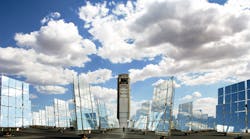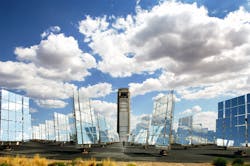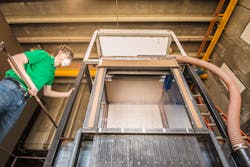Researchers at Sandia National Laboratories, Albuquerque, N. M., are refining a method of capturing the sun’s thermal energy using falling-particle technology. If their efforts are successful, results could lead to 100-MW power plants costing less than $150/kW to construct.
The technology lets sandlike ceramic particles fall through a beam of concentrated sunlight, heating the particles to nearly 1,000°C before they enter an insulated container. From the container they travel down through a heat-transfer device where they heat a working fluid such as water or carbon dioxide. The working fluid then gets sent through an electricity-generating turbine. After giving up most of their heat in the turbine, the particles fall into a reservoir where eventually they are elevatored up to repeat the cycle.
This approach to capturing solar thermal energy is an improvement over methods that use sunlight to heat nitrate salts. The salts break down and become unstable at about 600°C. The ceramic sand, which is less expensive than nitrate salts, can store thermal energy at higher temperatures, which pushes the thermal-to-electric efficiency of the process from 40 to 50% or more. The higher temperatures also mean less heat-capturing material is needed, so the overall system can be smaller and less costly.
Sandia engineers want to make the overall process 90% efficient using particles stored at 700°C. To do so, they plan on reducing the number of particles that get lost in processing, increasing the amount of time particles spend in the concentrated beam of sunlight, and limiting heat losses.
Researchers have already adjusted the size of the particles and how they drop to ensure more of the sand gets fully heated in a single pass and gets to the collection bin below. They are also exploring the use of air curtains that would make particles fall in a more-consistent manner and reduce convective heat losses. Other improvements include using an elevator to recirculate particles through the concentrated sunlight a second time to boost their temperature. The Sandia team expects to have a design for a test plant ready to be by 2015.


